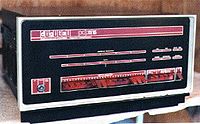Difference between revisions of "PDP-11/20"
| Line 22: | Line 22: | ||
The original operating system was DOS/BATCH, but one of the early versions of UNIX was also developed on the /20. | The original operating system was DOS/BATCH, but one of the early versions of UNIX was also developed on the /20. | ||
| − | [[Image:pdp1120a.jpg|200px|Another picture of the front panel]] | + | [[Image:pdp1120a.jpg|200px|thumb|Another picture of the front panel]] |
| − | |||
| − | [[Image:pdp1115.jpg|200px|The /15 was the OEM version]]. | + | |
| + | [[Image:pdp1115.jpg|200px|thumb|The /15 was the OEM version]]. | ||
Interesting options: MX11 - Memory Extension Option: this enabled the usage of 128 KW memory (18-bit addressing range); KS11: this option provided hardware memory protection, which the plain /20 lacked. Both options were developed by the Digital CSS (Computer Special Systems). | Interesting options: MX11 - Memory Extension Option: this enabled the usage of 128 KW memory (18-bit addressing range); KS11: this option provided hardware memory protection, which the plain /20 lacked. Both options were developed by the Digital CSS (Computer Special Systems). | ||
Revision as of 12:50, 4 May 2011
| PDP-11/20 | |
| Manufacturer: | Digital Equipment Corporation |
|---|---|
| Bus Architecture: | Unibus |
The PDP11/20 was the first PDP-11 to run Unix. Another thing that is interesting is that a coprocessor was required for the multiply/divide instructions, making this model incompatible from the rest of the PDP-11's.
hampage.hu
Quoted: The first of the -11's, born in June 1970, featuring the KA11 processor, built from Digital's M Series Integrated Circuit FLIP-CHIP Modules - small modules with TTL (Transistor-to-Transistor Logic) components.
The PDP-11/20 is a general-purpose computer with a wordlength of 16 bits. It features 8 general registers, and one interconnect for all system components (CPU, memory, peripheral devices), the UNIBUS (which is not the successor of the PDP8 OMNIBUS). This bus had an addressing range of 18 bits, but only 16 were used, which led to the 32 Kword (as mentioned, one word was 16 bits, so this is equal 64 Kbyte) memory limit. As with the other members of the -11 family, the top 4 KW of the memory is reserved to the system (the upper memory addresses refer to devices connected to the CPU). It is also interesting to know that most machines were shipped with only 12 KW of magnetic core memory.
On the picture to the left we can see some typical I/O devices: 4 ASR33 teletype terminals and DECtape drives over the an-fold papertape puncher/reader. The frontpanel had lights and switches for address and data (the lights were not LED's).
The original operating system was DOS/BATCH, but one of the early versions of UNIX was also developed on the /20.
Interesting options: MX11 - Memory Extension Option: this enabled the usage of 128 KW memory (18-bit addressing range); KS11: this option provided hardware memory protection, which the plain /20 lacked. Both options were developed by the Digital CSS (Computer Special Systems).
Trivia: The machine is said to be named "PDP-11/30" originally, but it was renamed to 11/20 because of the similar designation of the IBM 1130.
More information is available on the PDP-11 page...
| v • d • e PDP-11 Computers and Peripherals |
|---|
| UNIBUS PDP-11s - PDP-11/20 • PDP-11/15 • PDP-11/35 • PDP-11/40 • PDP-11/45 • PDP-11/50 • PDP-11/55 • PDP-11/70 PDP-11/05 • PDP-11/10 • PDP-11/04 • PDP-11/34 • PDP-11/60 • PDP-11/44 • PDP-11/24 • PDP-11/84 • PDP-11/94 QBUS PDP-11s - PDP-11/03 • PDP-11/23 • PDP-11/23+ • MicroPDP-11/73 • MicroPDP-11/53 • MicroPDP-11/83 • MicroPDP-11/93 QBUS CPUs: LSI-11 • LSI-11/2 • KDF11-A • KDF11-B • KDJ11-A • KDJ11-B • KDJ11-D • KDJ11-E Buses: UNIBUS • UNIBUS map • SPC • MUD • EUB • QBUS • CD interconnect • PMI Also: PDP-11 architecture • PDP-11 Extended Instruction Set • FP11 floating point • PDP-11 Memory Management |
| UNIBUS CPUs: KA11 • KC11 • KB11-A • KB11-B • KB11-C • KB11-D • KD11-A • KD11-B • KD11-D • KD11-E • KD11-EA • KD11-K • KD11-Z • KDF11-U
Co-processors: FP11-A • FP11-B • FP11-C • FP11-E • FP11-F • KE44-A • FPF11 Chips: LSI-11 • KEV11-A • KEV11-B • KEV11-C • F-11 • KEF11-A • KTF11-A • T-11 • J-11 • FPJ11 CPU options: KE11-E • KE11-F • KJ11-A • KT11-C • KT11-D • KK11-A • KK11-B • KT24 • KTJ11-B Rare CPU options: KS11 Memory Protection and Relocation option • KT11-B Paging Option • KUV11 Writeable Control Store Front panels: KY11-A • KY11-D • KY11-J • KY11-LA • KY11-LB • KY11-P More on buses: UNIBUS and QBUS termination • Bus Arbitration on the Unibus and QBUS • CTI BUS PDT-11s - PDT-11/110 • PDT-11/130 • PDT-11/150 CTI PDP-11s - PRO-325 • PRO-350 • PRO-380 Other: FIS floating point • PDP-11 Commercial Instruction Set • PDP-11 stacks • PDP-11 family differences |


